

Table of contents
- Pome fruit: 6 self-pollinators
- 7 self-fertile stone fruit trees
- 2 types of berries
- 5 exotics presented
There are numerous fruit trees that can easily pollinate themselves and thus save a lot of space in the garden, on the terrace or in the greenhouse. We present 20 species in detail.
Pome fruit: 6 self-pollinators
chokeberries(chokeberry)
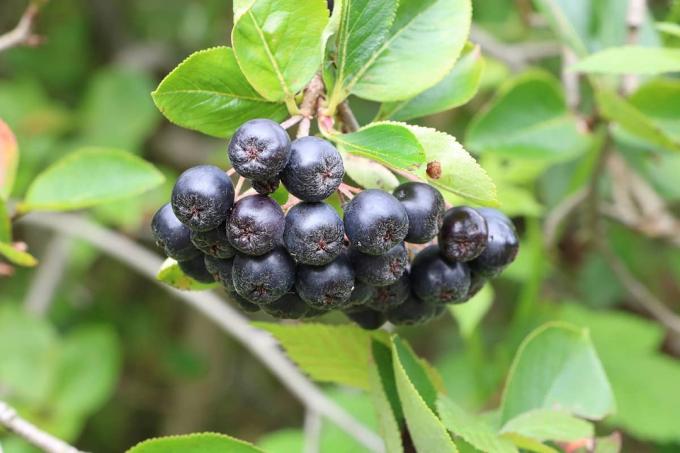
- all 3 species form edible fruits
- Growth height: up to 250 cm
- shrubby growth, upright, deciduous, dark green foliage
- educable as a standard to a fruit tree
- Flowering period: May to early June
- single double panicle flowers, white
- Harvest time: late August to mid-October
- Fruits black, round, extremely rich in vitamins, birds like to eat them
- sour aroma
- Self-pollinating attracts numerous pollinating insects
- sunny to half-shady, sandy, dry, fresh, well-drained
- hardy
Edible mountain ash 'Edulis'(Sorbus aucuparia 'Edulis')

- Growth height: 600 to 1,500 cm
- fast growth, slender, multi-stemmed, pyramidal crown, deciduous, dark green foliage
- Flowering period: May to mid-June
- single double umbels, white, many flowers
- Harvest time: end of August to beginning of November, first frost intensifies the taste
- Fruits are edible, pleasantly sour taste, orange or red, extremely rich in vitamins, birds like to eat them
- sunny to semi-shady, solitary position, not demanding on soil
- hardy
serviceberry(Sorbus torminalis)
- Growth height: 700 to 2,500 cm
- upright growth, dense, round crown, attractive autumn colors, deciduous, intense green foliage with bluish underside
- Flowering period: May to mid-July
- single double panicle flowers, white, small
- Harvest time: from October
- Fruits reddish to brown with white spots, apple-shaped, quite small, overripe fruits popular with birds
- Boil fruit before eating
- Taste reminiscent of marzipan or almonds
- Sunny to semi-shady, avoid salty soil, dry, fresh, nutritious, prefers lime, well-drained
- needs winter protection
medlar(Mespilus germanica)
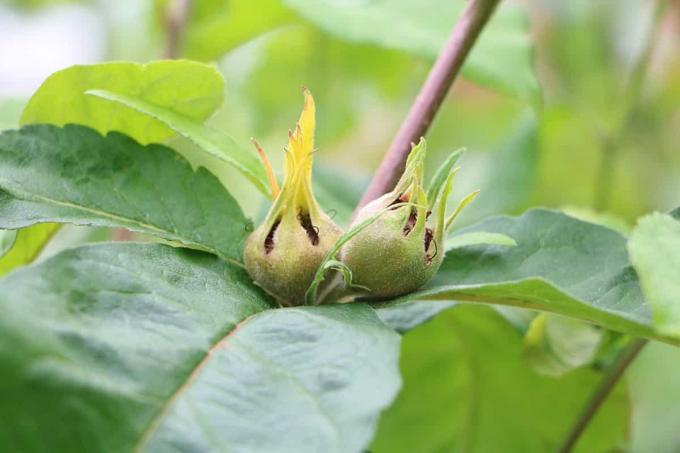
- Growth height: 500 to 600 cm
- crooked growth, broad crown, deciduous, intense green foliage
- Flowering period: late April to mid-June
- single double flowers, on short shoots, white, large
- Harvest time: late October to late November
- Fruits orange-brown, spherical, hairy, covered with small warts
- sweet aroma, fine acidity
- sunny to semi-shady, nutritious, calcareous
- hardy
quince(Cydonia oblonga)

- Growth height: 400 to 800 cm
- Shrubby small tree, upright, spreading crown, deciduous, dull green foliage
- Flowering period: May to mid-June
- single double flowers, white, pink, large
- Harvest time: October, check ripeness
- Fruits yellow, large (up to 500 g), pear-shaped, extremely rich in vitamins, covered with tannic fluff
- acidic sweet taste, skin intensely bitter
- wash and heat before consumption (eliminates bitter taste of peel)
- sunny to semi-shady, moist, fresh, deep, nutritious
- hardy
service tree(Sorbus domestica)
- Growth height: 400 to 3,000 cm
- short stem, broad, round crown, deciduous, glossy green foliage
- Flowering period: May to June
- single double umbels, white, many flowers
- Harvest time: September to the end of October
- Fruits are reddish-yellow to olive-brown, shaped like small apples or pears, quite large
- attracts pollinating insects and birds
- bitter taste, much tastier due to processing
- Sunny to semi-shady, fresh, nutritious, well-drained, does not tolerate salt
- hardy
- tolerates heat very well
7 self-fertile stone fruit trees
apricot(Prunus armeniaca)
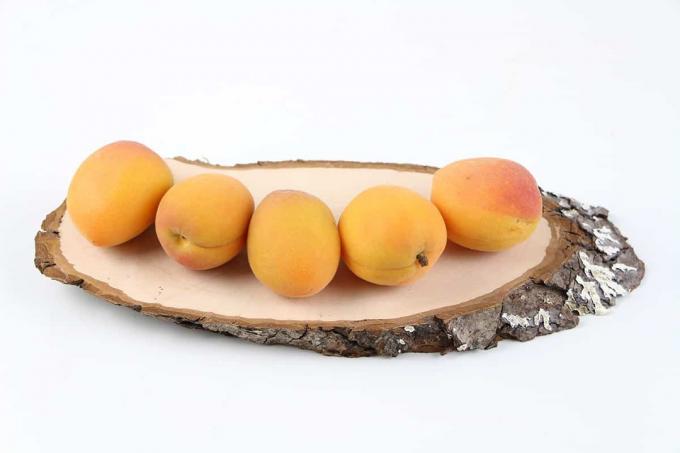
- also known as apricot
- Growth height: 500 to 1,000 cm
- Vigorous growth, broad crown, deciduous, green foliage
- Flowering time: March to April
- single double flowers, solitary or in pairs, white, pale pink
- Harvest time: mid-July to early September (at the latest)
- Fruits light yellow, orange, reddish, round, smooth, juicy, size depends on variety
- aromatic taste, sweet
- attracts pollinating insects
- sunny, humic, normal, permeable
- hardy, late frosts sometimes problematic
A notice:
If you want to cultivate the Cherrykose (apricot and cherry hybrid), you don't need pollinators either. They fertilize themselves easily.
Cowardly(Ficus carica)

- Growth height: 250 to 500 cm
- Growth habit depends heavily on the variety, mostly broad crown, twisted or bent trunk, deciduous
- forms irritating milky sap in all parts of the plant except the fruits
- Flowering time: March to mid-August (strongly dependent on climate)
- inconspicuous flowers
- Harvest time: mid-August to late December
- Fruits are green to violet in colour, soft flesh, characteristic shape
- sweet aroma
- sunny, loamy, loose, nutritious, acidic
- hardy, winter protection recommended
elder(Sambucus)

- Growth height: 100 to 1,500 cm
- loose growth, upright, deciduous, dark green foliage
- Flowering period: June to mid-July
- single double racemes, umbrella racemes or terminal flowers, white
- Harvest time: late September to mid-October
- Fruits red, blue or black, round, small
- tart aroma, sometimes bitter, sweet aftertaste
- Flowers also edible
- attracts pollinating insects and birds
- sunny to semi-shady, nutritious, moist, normal, well-drained
- hardy
peach(Prunus persica)
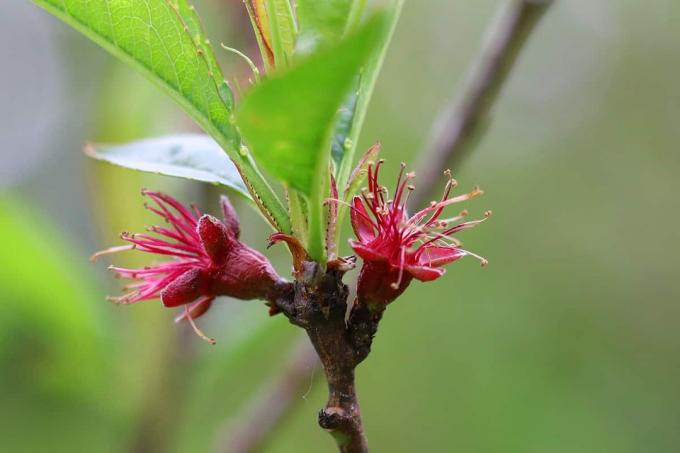
- Growth height: 100 to 800 cm
- well-branched growth, upright, crown mostly close to the ground, deciduous, mid-green foliage
- Flowering time: April to mid-May
- single double flowers, fivefold, yellow, pale pink, red
- Harvest time: late July to early September
- Fruits hairy, round or flat, juicy, greenish or yellow, usually red on the sunny side
- sour-sweet taste
- sunny to half-shady, humic, fresh and moist, well-drained
- hardy
- apricots (Prunus persica var. nucipersica) can also fertilize themselves
plum(Prunus domestica)
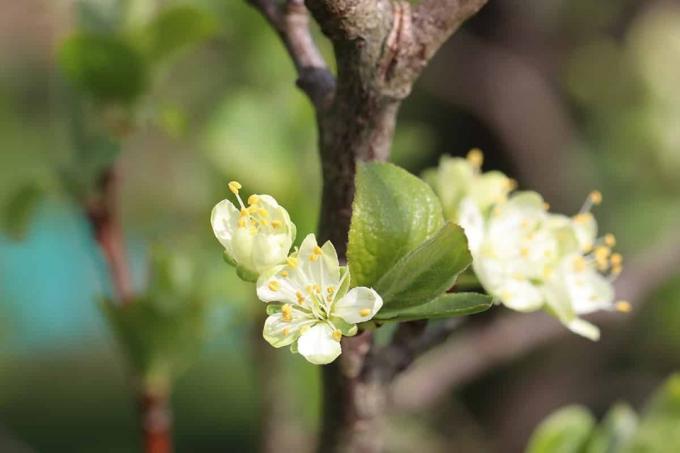
- Growth height: 600 to 1,000 cm
- medium growth, sparse, deciduous, intense green foliage
- Flowering time: April to mid-May
- Umbellate inflorescences, 2 to 3 flowers per inflorescence, white, white-green, yellow-green
- Harvest time: July to mid-October (depends heavily on the variety)
- Fruits yellow-greenish, yellow, reddish, purple, blue, blue-black, lilac, black, round or ovoid, smooth skin
- sweet to sour aroma (depending on variety and duration of ripening)
- sunny to half-shady, humic, fresh and moist, well-drained
- pollen donor
- hardy
A notice:
All plum subspecies such as damsons and mirabelle plums also belong to the self-pollinators. These can be recognized by the botanical name Prunus domestica subspecies.
sour cherries(Prunus cerasus)

- Growth height: 100 to 1,000 cm
- well-branched growth, upright, slightly hanging, deciduous, medium-green foliage
- Flowering time: April to May
- single double umbel flowers, white
- Harvest time: 4. and 5. Cherry week (2. July to 24. July)
- Fruits red or dark red, roundish, juicy
- Mild acidity in taste, tart to spicy
- sunny to half-shady, humic, fresh and moist, well-drained, nutritious
- hardy
Sweet Cherry 'Lapins'(Prunus avium 'Lapins')
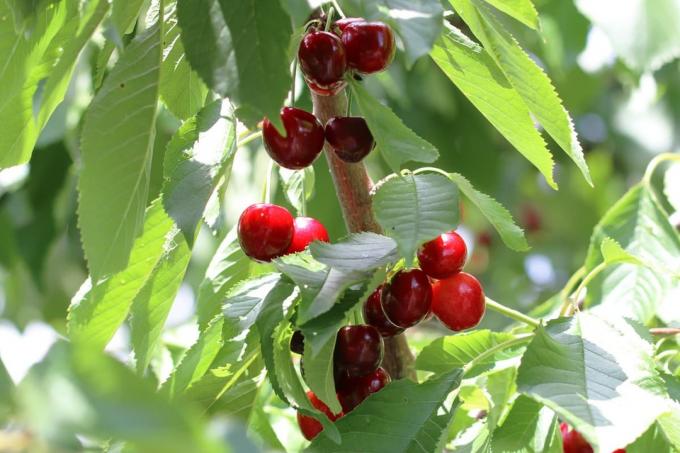
- one of the few self-pollinating varieties of the species
- Growth height: 300 to 600 cm
- compact growth, steep, sparsely branched, deciduous, soft green foliage
- Flowering time: April to May
- single filled, radial symmetric, white
- Harvest time: 6. and 7. Cherry week (26. July to 20 August)
- Fruits dark red, large, juicy
- sweet in taste
- sunny, normal, permeable
- hardy
2 types of berries
currants(Ribes species)

- Growth height: up to 150 cm
- upright habit, small tree, some species develop thorns, deciduous, intense green foliage
- Flowering period: May to early June
- single double, in umbellate, racemose or umbrella racemes inflorescences, white, greenish, yellowish, red, purple
- Harvest time: from St. John's Day (24. June) to the end of August (strongly dependent on species and variety)
- Fruits red or black, round, small
- Taste depends on the type and variety
- sunny to semi-shady, nutritious, humic
- hardy
Black mulberry(Morus nigra)
- Growth height: up to 1,200 cm
- upright habit, densely branched, decorative, rounded crown, deciduous, dark green foliage
- Flowering period: May to mid-June
- inconspicuous flowers, yellowish color
- Harvest time: July to mid-August
- Dark purple or black fruits, shape reminiscent of blackberries
- sweet and sour aroma, spicy character, intense
- sunny to half-shady, normal, prefers chalky soil, well-drained
- hardy, winter protection or winter quarters required in particularly cold areas
5 exotics presented
pomegranate(Punica granatum)

- Growth height: 250 to 500 cm
- bushy growth, upright, with thorns, deciduous, green foliage
- Flowering period: June to September
- single bell-shaped flowers, white, yellow, red
- Harvest time: September to mid-October (only from the 2nd standing year)
- large, red pods, filled with numerous seeds, juicy, round, juice stains
- sunny, sandy, loamy, fresh, well-drained, loose, requires a high proportion of minerals
- hardy to -5°C, hibernate in the winter quarters
persimmon(Diospyros persimmon)
- Growth height: 1,000 to 2,000 cm
- Growth reminiscent of apple trees, scaly bark, upright, deciduous, dark green foliage with light green underside
- Flowering period: May to June
- radially symmetrical flowers, yellowish, greenish, inconspicuous
- Harvest time: late September to late October
- large fruits, shape and color depending on the variety or subspecies, mostly yellow, orange, red, very rich in vitamins
- furry, needs to mature, then tart to sweet (depending on maturity)
- Sunny to semi-shady, sheltered, loamy, humic, deep, does not tolerate lime, rich in nutrients
- hardy to -15°C, winter protection may be necessary in cold regions
grapefruit(Citrus maxima)
- Growth height: up to 300 cm
- bushy habit, upright, sprawling, evergreen, with thorns in the leaf axils, light green foliage
- strongly varying flowering time
- solitary or in spikes, white
- Harvest time strongly dependent on flowering time (depending on the temperature, it sometimes fails)
- Fruits are green to yellow in color, round, very large (up to 20 cm in diameter), extremely rich in vitamins
- Taste fundamentally bitter with subtle sweetness or acidity
- sunny, well structured, permeable, with drainage
- not hardy, does not survive even the slightest frost
- exclusively bucket maintenance
Yuzu(Citrus junos)
- Growth height: 150 to 300 cm
- bushy habit, upright, with thorns, evergreen, intense green foliage
- Flowering period: May to early June
- simple, white
- Harvest time: October to December
- Fruits intensely yellow, rounded, extremely rich in vitamins
- sunny, semi-shade tolerable, protected, well structured, well-drained, with drainage, rich in nutrients
- hardy to -12°C, can be planted out in suitable locations, otherwise only keep in tubs
Lemons(citrus lime)
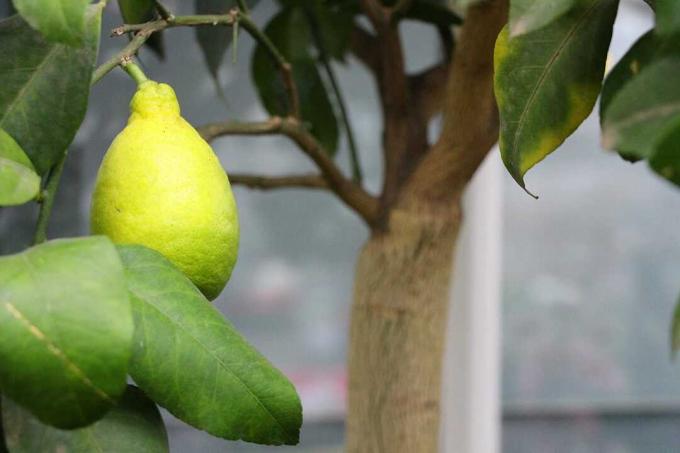
- Growth height: 400 to 500 cm
- bushy habit, upright, fast-growing compared to other citrus species, evergreen, green foliage
- Flowering period: May to mid-August
- single flowers, white, intense scent, sometimes even rotten
- Harvest time: September to the end of November (ripeness depends on size)
- high yields possible
- Fruits sunny yellow, fist-sized, oval, oblong
- intense sour taste
- sunny, ideally facing south, sheltered, high-quality citrus soil recommended for fruit trees, humic, well-drained
- not hardy, winter protection or winter quarters necessary
 Home editorial office
Home editorial office
Learn more about orchard care
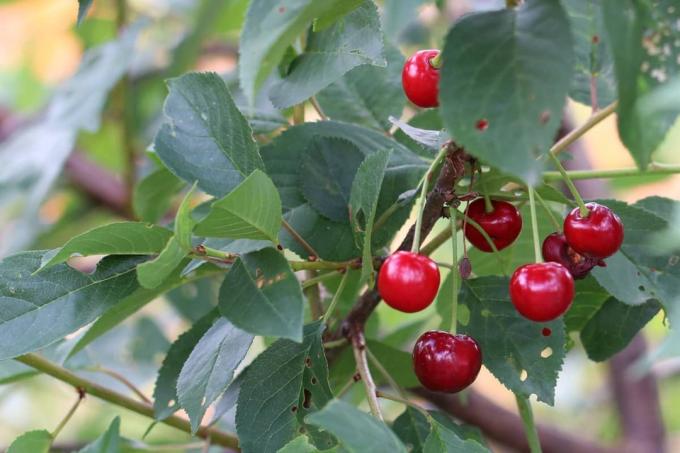
Sour cherry - care instructions: Tips for the morello cherry
The sour cherry (Prunus cerasus) is ideal for smaller gardens because it grows small or shrub-like. Experts have a few tips to ensure that planting and harvesting works.

Pruning a plum tree – instructions | When is the best time?
Pruning a plum tree is essential to ensure the highest possible yield for years to come and to keep the crop healthy. But when is the best time to do this and how should the blending be done? We tell.

Maintain espalier fruit trees | 5 tips on planting distance & care
Espalier fruit trees are an ornament for every garden and enliven unadorned walls and walls. It is true that creating it is very labor-intensive, but the effort is rewarded with a decorative appearance and sweet fruits. Certain factors must be taken into account when it comes to care and a sufficient planting distance.

Fruit tree diseases: recognizing common diseases
There is hardly a garden without fruit trees. They look splendid, give us shade and their fruits. Unfortunately, diseases sometimes spread. They can threaten the harvest and even the life of the tree. What are the clear signs?

The Best Fruit Tree Fertilizers - Basics of fruit tree fertilization
In order for fruit trees in the home garden to grow healthy and strong and to bear a variety of fruits, a balanced supply of nutrients must be guaranteed. In this article you will find out when, with what and how best to fertilize your fruit trees.

Fight fruit tree pests - overview of the pests
The scourge in the orchard has names such as cherry fruit fly, codling moth or winter moth. Although they differ in appearance and lifestyle, the pests all spoil our appetite for fresh fruit from our own harvest. This overview describes all the important fruit tree pests and gives tips for combating them.
